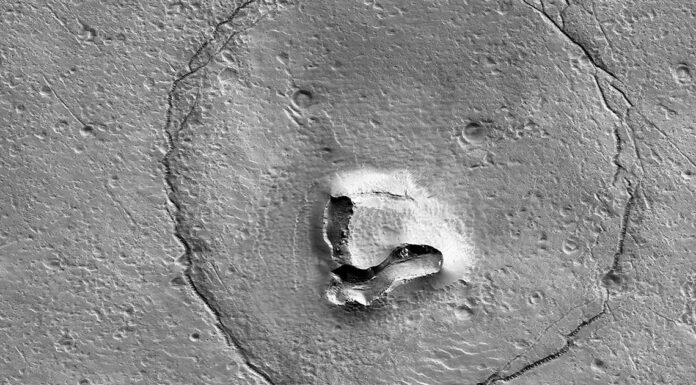Since ancient times, people have turned to the sky for signs. And because of the eye’s tendency to look for and recognize patterns, even in random formations and information, people have found them.
Whether we’re talking about cloud formations or constellations, the human imagination has run wild over the millennia, attempting to find meaning in the seemingly meaningless. The phenomenon is known as pareidolia and has led to some head-scratching “discoveries” in history.
Of course, the advent of space travel and satellites means there’s more of the sky and outer space to examine than ever before. And this has contributed to iconic sightings like the Face on Mars and the Horsehead Nebula. Lesser-known, though no less dramatic, examples of space pareidolia include a side profile of an elephant and a floating spoon, both on Mars.

Credit: NASA/JPL-Caltech/UArizona.
But hands down, the cutest example of space pareidolia is the Martian teddy bear image recently released by the University of Arizona.
Pareidolia on Earth and Beyond
Pareidolia is a fascinating phenomenon that scientists continue to study. It influences people to see strange faces and formations in the sky, heavenly bodies, and outer space, and it also accounts for other unexpected imagery. Some examples are more famous than others, even earning a whole category of study. Think the face of Jesus in toast or the Virgin Mary in everything from gourds to high-rise office window stains.
But when pareidolia moves to outer space, things tend to go from miraculous to extraterrestrial. Take, for example, the strange case of the Face on Mars. First photographed in 1976 by Viking 1, a Mars Global Surveyor, scientists quickly identified and labeled it as a mesa.

Credit: NASA/JPL-Caltech/UArizona.
But that didn’t stop the most salacious news outlets from declaring the land feature an alien artifact. As a result, the face went on to great fame. But the Face on Mars has nothing on the adorable teddy bear image scientists recently captured on the Martian surface.
An Ancient Crater and a Broken Hill
On January 25, 2023, astronomers at the University of Arizona released an image of the surface of Mars that’s about as cuddly and cute as it gets. The photograph channels Paddington Bear from his grinning mouth to his button nose and teeny-tiny eyes. The photo was taken on December 12, 2022, by NASA’s Mars Reconnaissance Orbiter (MRO) while it cruised 156 miles above the planet’s surface.
So, what’s going on in this photo? A statement published on the University of Arizona’s High Resolution Imaging Science Experiment (HiRISE) page says this about the chubby bruin: “There’s a hill with a V-shaped collapse structure (the nose), two craters (the eyes), and a circular fracture pattern (the head). The circular fracture pattern might be due to the settling of a deposit over a buried impact crater.”

Credit: NASA/JPL-Caltech/UArizona.
What accounts for the semi-collapsed appearance of the bear’s muzzle? Researchers hypothesize we could be looking at a mud vent or volcanic vent along with a deposit of lava or mud.
Of course, nothing in life is perfect, and the Mars ursine face is missing a couple of important pieces essential to successfully being a Paddington Bear doppelganger. Namely, the little guy lacks fluffy ears and a red bucket hat. Nevertheless, the fourth planet from the Sun’s topographic homage to everyone’s favorite marmalade-loving Peruvian cub remains undeniably adorable, even if aliens didn’t secretly engineer him.
By Engrid Barnett, contributor for Ripleys.com
EXPLORE THE ODD IN PERSON!
Hits: 0











